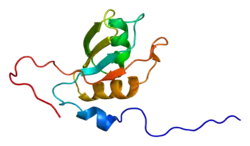TIAL1
Nucleolysin TIAR is a protein that in humans is encoded by the TIAL1 gene.[5][6]
| TIAL1 | |||||||||||||||||||||||||||||||||||||||||||||||||||
|---|---|---|---|---|---|---|---|---|---|---|---|---|---|---|---|---|---|---|---|---|---|---|---|---|---|---|---|---|---|---|---|---|---|---|---|---|---|---|---|---|---|---|---|---|---|---|---|---|---|---|---|
 | |||||||||||||||||||||||||||||||||||||||||||||||||||
| |||||||||||||||||||||||||||||||||||||||||||||||||||
| Identifiers | |||||||||||||||||||||||||||||||||||||||||||||||||||
| Aliases | TIAL1, TCBP, TIAR, TIA1 cytotoxic granule-associated RNA binding protein-like 1, TIA1 cytotoxic granule associated RNA binding protein like 1 | ||||||||||||||||||||||||||||||||||||||||||||||||||
| External IDs | OMIM: 603413 MGI: 107913 HomoloGene: 87796 GeneCards: TIAL1 | ||||||||||||||||||||||||||||||||||||||||||||||||||
| |||||||||||||||||||||||||||||||||||||||||||||||||||
| |||||||||||||||||||||||||||||||||||||||||||||||||||
| |||||||||||||||||||||||||||||||||||||||||||||||||||
| |||||||||||||||||||||||||||||||||||||||||||||||||||
| |||||||||||||||||||||||||||||||||||||||||||||||||||
| Wikidata | |||||||||||||||||||||||||||||||||||||||||||||||||||
| |||||||||||||||||||||||||||||||||||||||||||||||||||
The protein encoded by this gene is a member of a family of RNA-binding proteins, has three RNA recognition motifs (RRMs), and binds adenine and uridine-rich elements in mRNA and pre-mRNAs of a wide range of genes. It regulates various activities including translational control, splicing and apoptosis. Alternate transcriptional splice variants, encoding different isoforms, have been characterized. The different isoforms have been shown to function differently with respect to post-transcriptional silencing.[6]
References
- GRCh38: Ensembl release 89: ENSG00000151923 - Ensembl, May 2017
- GRCm38: Ensembl release 89: ENSMUSG00000030846 - Ensembl, May 2017
- "Human PubMed Reference:". National Center for Biotechnology Information, U.S. National Library of Medicine.
- "Mouse PubMed Reference:". National Center for Biotechnology Information, U.S. National Library of Medicine.
- Kawakami A, Tian Q, Duan X, Streuli M, Schlossman SF, Anderson P (Oct 1992). "Identification and functional characterization of a TIA-1-related nucleolysin". Proc Natl Acad Sci U S A. 89 (18): 8681–5. Bibcode:1992PNAS...89.8681K. doi:10.1073/pnas.89.18.8681. PMC 49984. PMID 1326761.
- "Entrez Gene: TIAL1 TIA1 cytotoxic granule-associated RNA binding protein-like 1".
Further reading
- Taupin JL, Tian Q, Kedersha N, et al. (1995). "The RNA-binding protein TIAR is translocated from the nucleus to the cytoplasm during Fas-mediated apoptotic cell death". Proc. Natl. Acad. Sci. U.S.A. 92 (5): 1629–33. Bibcode:1995PNAS...92.1629T. doi:10.1073/pnas.92.5.1629. PMC 42573. PMID 7533298.
- Dember LM, Kim ND, Liu KQ, Anderson P (1996). "Individual RNA recognition motifs of TIA-1 and TIAR have different RNA binding specificities". J. Biol. Chem. 271 (5): 2783–8. doi:10.1074/jbc.271.5.2783. PMID 8576255.
- Doi T, Minami T, Itoh M, et al. (1997). "An alternative form of nucleolysin binds to a T-cluster DNA in the silencer element of platelet factor 4 gene". Biochem. Biophys. Res. Commun. 235 (3): 625–30. doi:10.1006/bbrc.1997.6817. PMID 9207209.
- Jin K, Li W, Nagayama T, et al. (2000). "Expression of the RNA-binding protein TIAR is increased in neurons after ischemic cerebral injury". J. Neurosci. Res. 59 (6): 767–74. doi:10.1002/(SICI)1097-4547(20000315)59:6<767::AID-JNR9>3.0.CO;2-K. PMID 10700014. S2CID 33671199.
- Le Guiner C, Lejeune F, Galiana D, et al. (2001). "TIA-1 and TIAR activate splicing of alternative exons with weak 5' splice sites followed by a U-rich stretch on their own pre-mRNAs". J. Biol. Chem. 276 (44): 40638–46. doi:10.1074/jbc.M105642200. PMID 11514562.
- Iseni F, Garcin D, Nishio M, et al. (2002). "Sendai virus trailer RNA binds TIAR, a cellular protein involved in virus-induced apoptosis". EMBO J. 21 (19): 5141–50. doi:10.1093/emboj/cdf513. PMC 129035. PMID 12356730.
- Li W, Li Y, Kedersha N, et al. (2002). "Cell proteins TIA-1 and TIAR interact with the 3' stem-loop of the West Nile virus complementary minus-strand RNA and facilitate virus replication". J. Virol. 76 (23): 11989–2000. doi:10.1128/JVI.76.23.11989-12000.2002. PMC 136884. PMID 12414941.
- Yu Q, Cok SJ, Zeng C, Morrison AR (2003). "Translational repression of human matrix metalloproteinases-13 by an alternatively spliced form of T-cell-restricted intracellular antigen-related protein (TIAR)". J. Biol. Chem. 278 (3): 1579–84. doi:10.1074/jbc.M203526200. PMID 12426321.
- Strausberg RL, Feingold EA, Grouse LH, et al. (2003). "Generation and initial analysis of more than 15,000 full-length human and mouse cDNA sequences". Proc. Natl. Acad. Sci. U.S.A. 99 (26): 16899–903. Bibcode:2002PNAS...9916899M. doi:10.1073/pnas.242603899. PMC 139241. PMID 12477932.
- Le Guiner C, Gesnel MC, Breathnach R (2003). "TIA-1 or TIAR is required for DT40 cell viability". J. Biol. Chem. 278 (12): 10465–76. doi:10.1074/jbc.M212378200. PMID 12533540.
- Cok SJ, Acton SJ, Morrison AR (2003). "The proximal region of the 3'-untranslated region of cyclooxygenase-2 is recognized by a multimeric protein complex containing HuR, TIA-1, TIAR, and the heterogeneous nuclear ribonucleoprotein U." J. Biol. Chem. 278 (38): 36157–62. doi:10.1074/jbc.M302547200. PMID 12855701.
- Zhu H, Hasman RA, Young KM, et al. (2003). "U1 snRNP-dependent function of TIAR in the regulation of alternative RNA processing of the human calcitonin/CGRP pre-mRNA". Mol. Cell. Biol. 23 (17): 5959–71. doi:10.1128/MCB.23.17.5959-5971.2003. PMC 180986. PMID 12917321.
- Ota T, Suzuki Y, Nishikawa T, et al. (2004). "Complete sequencing and characterization of 21,243 full-length human cDNAs". Nat. Genet. 36 (1): 40–5. doi:10.1038/ng1285. PMID 14702039.
- Shukla S, Dirksen WP, Joyce KM, et al. (2004). "TIA proteins are necessary but not sufficient for the tissue-specific splicing of the myosin phosphatase targeting subunit 1". J. Biol. Chem. 279 (14): 13668–76. doi:10.1074/jbc.M314138200. PMID 14736875.
- Esclatine A, Taddeo B, Roizman B (2004). "Herpes simplex virus 1 induces cytoplasmic accumulation of TIA-1/TIAR and both synthesis and cytoplasmic accumulation of tristetraprolin, two cellular proteins that bind and destabilize AU-rich RNAs". J. Virol. 78 (16): 8582–92. doi:10.1128/JVI.78.16.8582-8592.2004. PMC 479066. PMID 15280467.
- Hua Y, Zhou J (2004). "Survival motor neuron protein facilitates assembly of stress granules". FEBS Lett. 572 (1–3): 69–74. doi:10.1016/j.febslet.2004.07.010. PMID 15304326. S2CID 27599172.
- Suswam EA, Nabors LB, Huang Y, et al. (2005). "IL-1beta induces stabilization of IL-8 mRNA in malignant breast cancer cells via the 3' untranslated region: Involvement of divergent RNA-binding factors HuR, KSRP and TIAR". Int. J. Cancer. 113 (6): 911–9. doi:10.1002/ijc.20675. PMID 15514971. S2CID 33272692.
- Rush J, Moritz A, Lee KA, et al. (2005). "Immunoaffinity profiling of tyrosine phosphorylation in cancer cells". Nat. Biotechnol. 23 (1): 94–101. doi:10.1038/nbt1046. PMID 15592455. S2CID 7200157.
- Suswam EA, Li YY, Mahtani H, King PH (2005). "Novel DNA-binding properties of the RNA-binding protein TIAR". Nucleic Acids Res. 33 (14): 4507–18. doi:10.1093/nar/gki763. PMC 1184220. PMID 16091628.
External links
This article is issued from Wikipedia. The text is licensed under Creative Commons - Attribution - Sharealike. Additional terms may apply for the media files.









